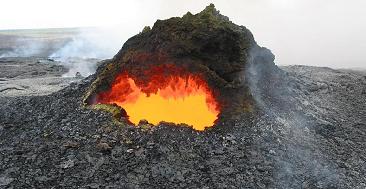
Home > Earth > Volcanoes > Cinder Cones
What is a Cinder Cone?
These are the classic, cone-shaped peaks we commonly associate with a lava-spewing eruption. Eruptions from cinder cones are pretty small potatoes, as far as volcanic eruptions go. They tend to be small, hill-sized volcanoes that range in height from tens to hundreds of meters high and they can build up over short periods of a few months to a few years. Cinder cones are characterized by their steeply angled sides and conical shapes. In fact, these mini-volcanoes are most often found on the flanks of larger, mountain-sized volcanic peaks.What type of volcano was the Iceland Volcano? ->
 In a cinder cone, lava erupts from a small vent in the crust and 'sprays' melted rock fragments into the air where they then fall back to earth in a pile. These rock fragments are glassy, gas-filled chunks of lava called cinders or scoria
that cool rapidly as they sail through the air and land next to the vent opening, slowly accumulating in the geometric shape of a cone. Some of the most dramatic volcanic eruptions are these displays of lava fountains shooting sparkling, glowing glass-like rock fragments into the air from cinder cones.
In a cinder cone, lava erupts from a small vent in the crust and 'sprays' melted rock fragments into the air where they then fall back to earth in a pile. These rock fragments are glassy, gas-filled chunks of lava called cinders or scoria
that cool rapidly as they sail through the air and land next to the vent opening, slowly accumulating in the geometric shape of a cone. Some of the most dramatic volcanic eruptions are these displays of lava fountains shooting sparkling, glowing glass-like rock fragments into the air from cinder cones.
Get Your Degree!
Find schools and get information on the program that’s right for you.
Powered by Campus Explorer